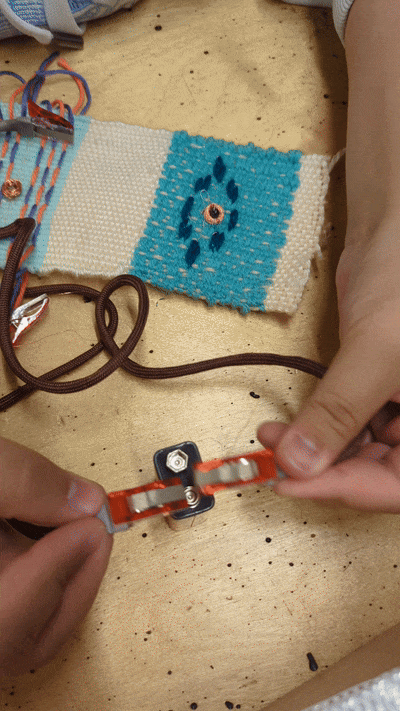4. Make a 1-Bit Flipping Bead #

This week, we are going to work on making an electromagnet and weaving it into the cloth.
Materials #
| Item | Qty | Location |
|---|---|---|
| Magnet Wire | 5 yds | kit |
| Pencil of Pen | 5 yds | you |
| Magnetic Beads | 3 | kit |
| 9V Battery | 1 | kit |
| 4.7 kOhm Resistor | 5 | kit |
| Thread | 12" | you or in class |
| Scissors | 1 | you |
| Warped Cricket Loom | 1 | from weekly 2 |
| Weft Yarns | 10 yds | in class |
| Connectors | 3 | from Weekly 3 |
| Lighter | 1 | you |
| Multimeter | 1 | you |
Requirements #
Wrap the magnet wire provided in class about 200 times around a pencil or pen, leaving each end of the wire loose, about 12" long. Gently pull the coil of wire off of the pen and use a piece of thread and your needle to tie the coil together. You have just created an electromagnetic coil. Repeat this process so you have 2 coils.
Your weekly this week will focus on how you might integrate these coils into your weaving using supplemental weft techniques. Make at least 2 swatches that explore supplemental weft techniques (e.g. inlay or overshot shown in class). Integrate 1 coil into each swatch.
What To Document In Your Weekly #
Your weekly should focus on experimentation integrating the coils and developing your draft: Consider how you can make the traces of the coil easy to connect to, how they can be decorative, or how they can be entirely hidden while secure to the cloth.
Turn In #
Turn your documentation into Canvas. Cut and finish your swatches and bring them to class. Also bring your lighter to class. When you bring your swatches to class, we will hook them up to the battery and resistor to show how they can be used to create a 1-bit flipping switch.
Acknowledgements #
Thanks to Irene Posch for for walking me through the process!